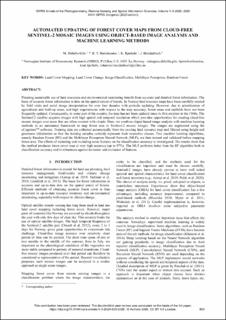| dc.contributor.author | Debella-Gilo, Misganu | |
| dc.contributor.author | Borchsenius, Bjørn Tobias | |
| dc.contributor.author | Bjørkelo, Knut | |
| dc.contributor.author | Breidenbach, Johannes | |
| dc.date.accessioned | 2020-10-02T11:35:29Z | |
| dc.date.available | 2020-10-02T11:35:29Z | |
| dc.date.created | 2020-08-04T09:45:11Z | |
| dc.date.issued | 2020-08-03 | |
| dc.identifier.citation | ISPRS Ann. Photogramm. Remote Sens. Spatial Inf. Sci., V-3-2020, 803–807, 2020 | en_US |
| dc.identifier.issn | 2194-9042 | |
| dc.identifier.uri | https://hdl.handle.net/11250/2680925 | |
| dc.description.abstract | Planning sustainable use of land resources and environmental monitoring benefit from accurate and detailed forest information. The basis of accurate forest information is data on the spatial extent of forests. In Norway land resource maps have been carefully created by field visits and aerial image interpretation for over four decades with periodic updating. However, due to prioritization of agricultural and built-up areas, and high requirements with respect to the map accuracy, forest areas and outfields have not been frequently updated. Consequently, in some part of the country, the map has not been updated since its first creation in the 1960s. The Sentinel-2 satellite acquires images with high spatial and temporal resolution which provides opportunities for creating cloud-free mosaic images over areas that are often covered with clouds. Here, we combine object-based image analysis with machine learning methods in an automated framework to map forest area in Sentinel-2 mosaic images. The images are segmented using the eCogntion™ software. Training data are collected automatically from the existing land resource map and filtered using height and greenness information so that the training samples certainly represent their respective classes. Two machine learning algorithms, namely Random Forest (RF) and the Multilayer Perceptron Neural Network (MLP), are then trained and validated before mapping forest area. The effects of including and excluding some features on the classification accuracy is investigated. The results show that the method produces forest cover map at very high accuracy (up to 97%). The MLP performs better than the RF algorithm both in classification accuracy and in robustness against inclusion and exclusion of features. | en_US |
| dc.language.iso | eng | en_US |
| dc.publisher | The International Society for Photogrammetry and Remote Sensing | en_US |
| dc.rights | Navngivelse 4.0 Internasjonal | * |
| dc.rights.uri | http://creativecommons.org/licenses/by/4.0/deed.no | * |
| dc.title | AUTOMATED UPDATING OF FOREST COVER MAPS FROM CLOUD-FREE SENTINEL-2 MOSAIC IMAGES USING OBJECT-BASED IMAGE ANALYSIS AND MACHINE LEARNING METHODS | en_US |
| dc.type | Peer reviewed | en_US |
| dc.type | Journal article | en_US |
| dc.description.version | publishedVersion | en_US |
| dc.rights.holder | © Author(s) 2020. | en_US |
| dc.source.pagenumber | 803-807 | en_US |
| dc.source.volume | V-3 2020 | en_US |
| dc.source.journal | ISPRS Annals of the Photogrammetry, Remote Sensing and Spatial Information Sciences | en_US |
| dc.identifier.doi | 10.5194/isprs-annals-V-3-2020-803-2020 | |
| dc.identifier.cristin | 1821469 | |
| cristin.ispublished | true | |
| cristin.fulltext | original | |
| cristin.qualitycode | 1 | |

